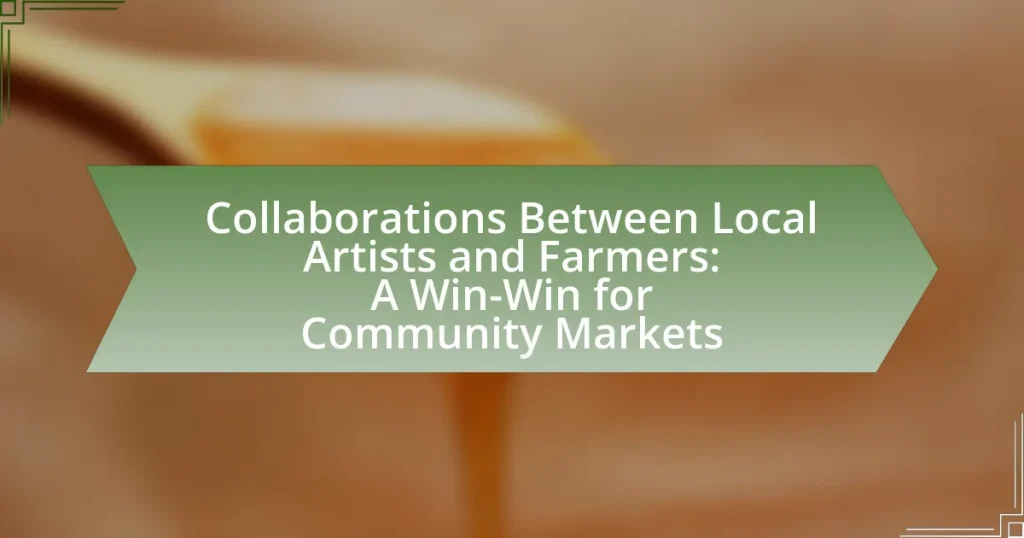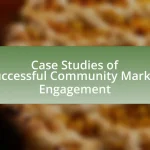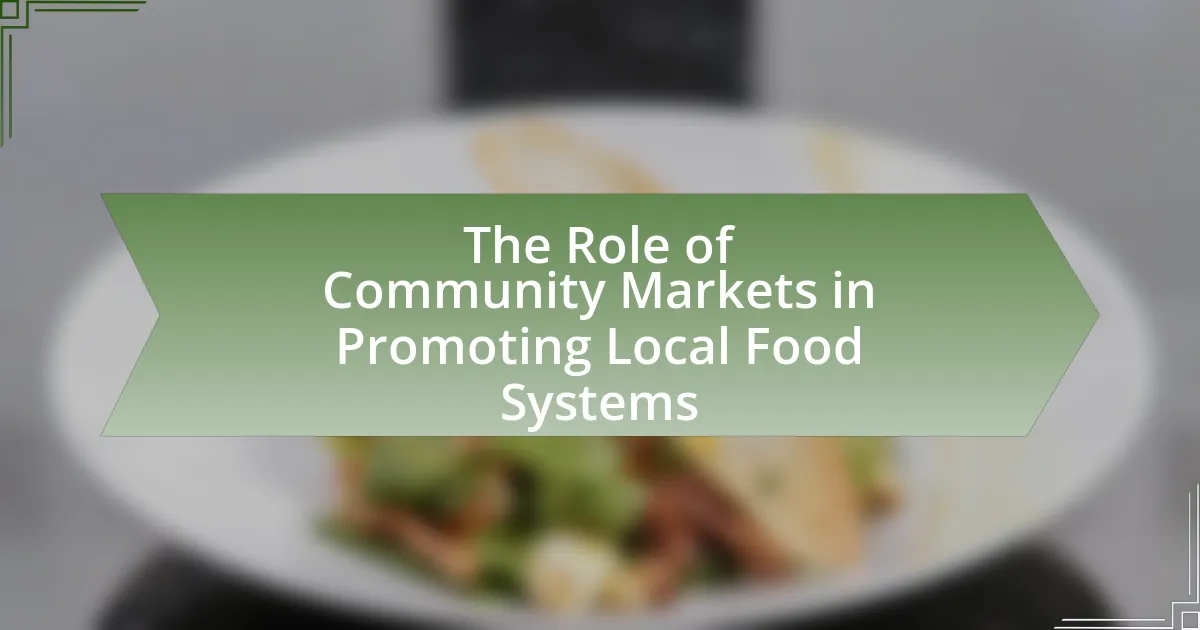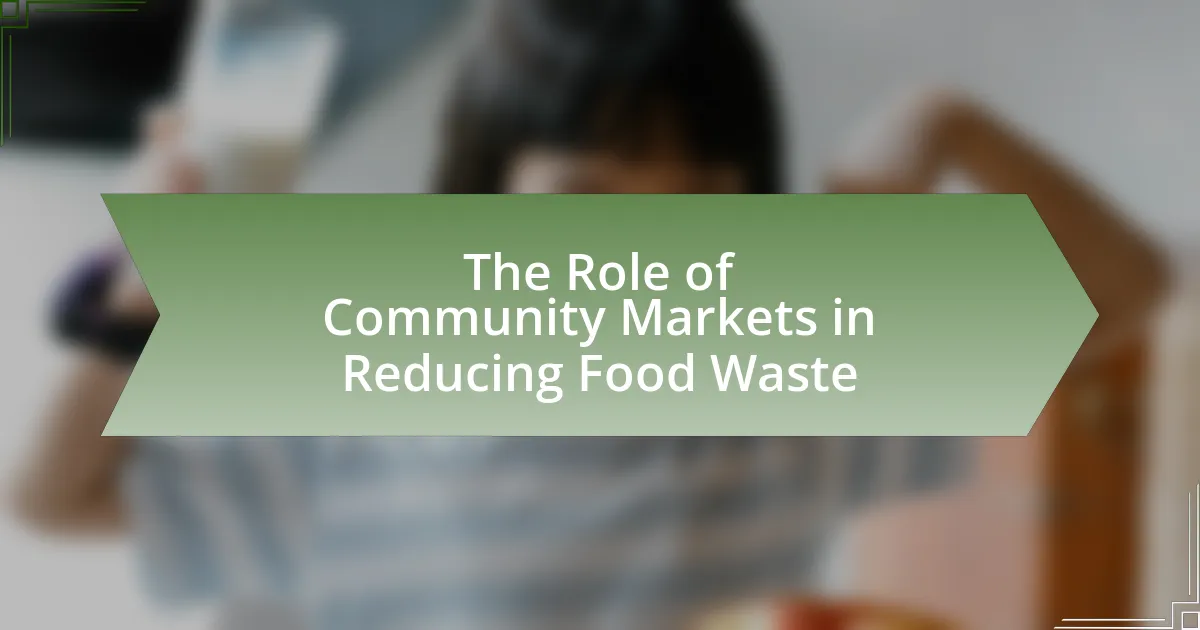Collaborations between local artists and farmers represent a synergistic partnership that enhances community markets by integrating artistic expression with agricultural products. These collaborations benefit both parties by increasing visibility, attracting diverse customer bases, and fostering community engagement. Local artists contribute by creating artwork and promotional materials that beautify market spaces, while farmers provide fresh produce that inspires artistic creations. The article explores the economic impacts of these partnerships, the roles of artists and farmers, the challenges they face, and best practices for successful collaboration, highlighting the importance of these initiatives for local economies and cultural sustainability.
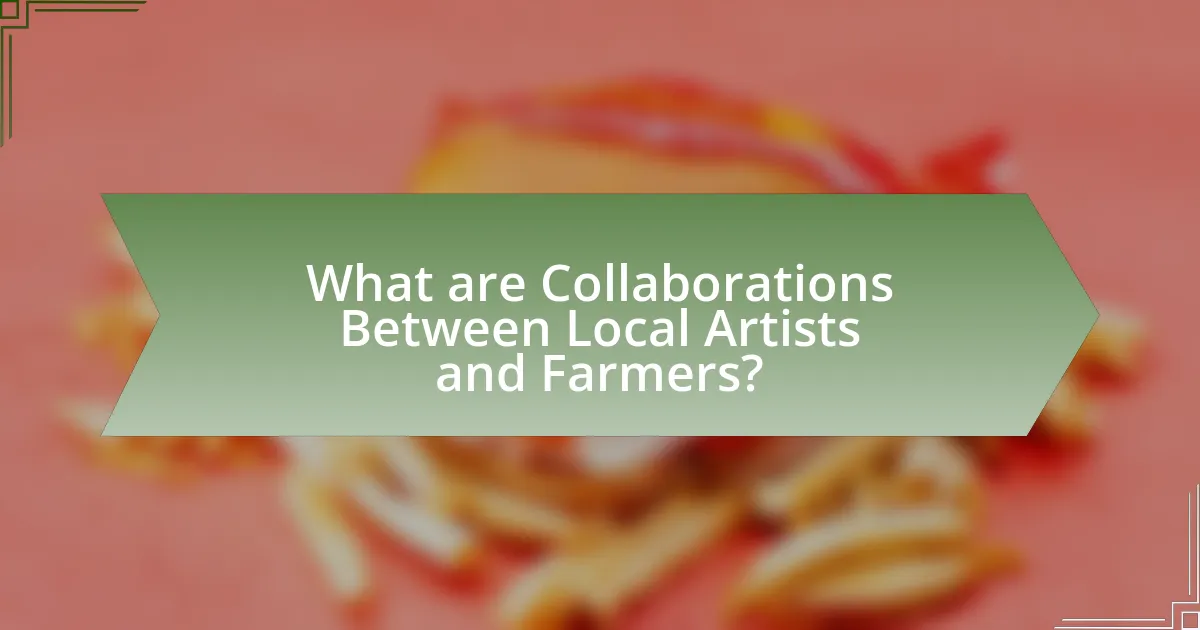
What are Collaborations Between Local Artists and Farmers?
Collaborations between local artists and farmers involve joint efforts where artists create works inspired by agricultural themes or directly using farm products, while farmers benefit from increased visibility and sales. These partnerships often manifest in community markets, where artists showcase their creations alongside fresh produce, enhancing the market’s appeal and fostering a sense of community. For example, events like art shows at farmers’ markets can draw larger crowds, benefiting both artists and farmers economically and socially.
How do these collaborations benefit community markets?
Collaborations between local artists and farmers benefit community markets by enhancing product visibility and attracting diverse customer bases. These partnerships create unique market experiences, such as art displays alongside fresh produce, which draw in more visitors. For instance, markets that feature local art often report increased foot traffic and sales, as the combination of visual appeal and fresh goods encourages community engagement. Additionally, these collaborations foster a sense of community identity and support local economies, as they promote both artistic and agricultural endeavors.
What roles do local artists play in these collaborations?
Local artists play a crucial role in collaborations with farmers by enhancing the visibility and appeal of community markets. They contribute through creative expression, such as designing promotional materials, creating artwork for market spaces, and organizing events that attract visitors. This artistic involvement not only beautifies the market environment but also fosters a sense of community and cultural identity. For instance, studies have shown that markets featuring local art can increase foot traffic by up to 30%, demonstrating the tangible benefits of these collaborations for both artists and farmers.
How do farmers contribute to these partnerships?
Farmers contribute to partnerships with local artists by providing fresh produce and agricultural products that enhance the artistic experience at community markets. This collaboration allows artists to create works inspired by the local landscape and farming practices, while farmers benefit from increased visibility and sales opportunities. For instance, farmers can showcase their goods alongside art, attracting more visitors and fostering a vibrant community atmosphere. This mutual support strengthens local economies and promotes sustainable practices, as evidenced by numerous community market initiatives that report increased foot traffic and sales due to such collaborations.
Why are these collaborations important for local economies?
Collaborations between local artists and farmers are important for local economies because they stimulate economic growth and enhance community engagement. These partnerships create unique market opportunities that attract consumers, thereby increasing sales for both artists and farmers. For instance, community markets featuring local art and produce can draw larger crowds, leading to a 20% increase in foot traffic and sales, as reported by the National Endowment for the Arts. Additionally, these collaborations foster a sense of community identity and pride, which can lead to increased local investment and support for small businesses.
What economic impacts do they have on community markets?
Collaborations between local artists and farmers positively impact community markets by enhancing economic activity and increasing consumer engagement. These partnerships often lead to unique products that attract more visitors, thereby boosting sales for both artists and farmers. For instance, farmers’ markets that feature local art can see a 20% increase in foot traffic, as reported by the American Farmers Market Association. This increase in visitors translates to higher revenue for vendors and fosters a sense of community, which can lead to sustained economic growth.
How do they promote local culture and sustainability?
Collaborations between local artists and farmers promote local culture and sustainability by creating community markets that showcase regional art and agricultural products. These markets provide a platform for artists to display their work, reflecting local heritage and traditions, while farmers offer fresh, locally sourced produce, reducing carbon footprints associated with transportation. This synergy fosters economic resilience and encourages the community to support local artisans and sustainable farming practices, thereby enhancing cultural identity and environmental stewardship.
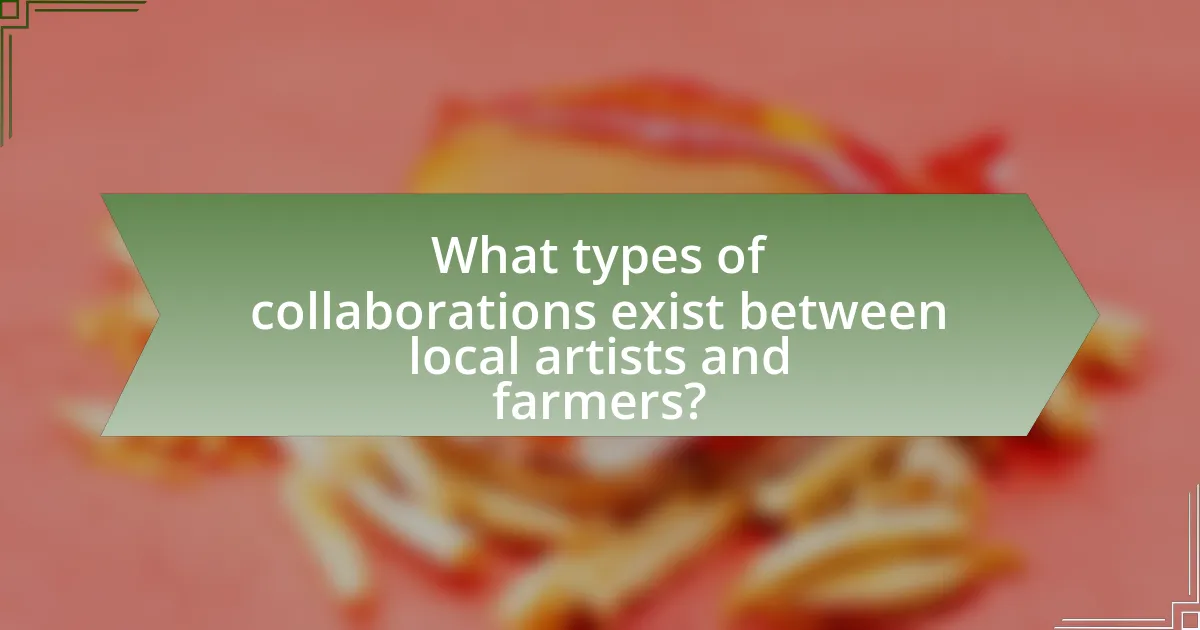
What types of collaborations exist between local artists and farmers?
Local artists and farmers engage in various collaborations, including art installations on farms, community art projects that highlight agricultural themes, and farmers’ markets featuring local art. These partnerships often result in unique experiences that promote local culture and sustainability. For instance, art installations can enhance the aesthetic appeal of farms, attracting visitors and increasing foot traffic. Additionally, community art projects can foster a sense of belonging and raise awareness about local farming practices. Farmers’ markets that showcase local art not only support artists but also create a vibrant atmosphere that encourages community engagement and economic growth.
How do art and agriculture intersect in community markets?
Art and agriculture intersect in community markets through collaborative initiatives that enhance local culture and promote sustainable practices. Local artists often create visual displays, signage, and promotional materials that highlight agricultural products, making them more appealing to consumers. This artistic representation not only beautifies the market environment but also educates visitors about the importance of local farming and seasonal produce. For instance, farmers’ markets frequently feature art installations or live performances that draw in crowds, thereby increasing foot traffic and sales for farmers. Additionally, events like art and agriculture festivals showcase the synergy between these two sectors, fostering community engagement and supporting local economies. This intersection is validated by studies showing that markets incorporating art see increased customer satisfaction and loyalty, benefiting both artists and farmers alike.
What are examples of successful artist-farmer collaborations?
Successful artist-farmer collaborations include the “Art in the Garden” project in which local artists create installations in community gardens, enhancing the aesthetic appeal and attracting visitors. Another example is the “Farm to Table” initiative where artists design labels and packaging for local produce, increasing marketability and consumer interest. Additionally, the “Harvest Festival” events often feature local artists showcasing their work alongside farmers, fostering community engagement and supporting local economies. These collaborations not only promote art and agriculture but also strengthen community ties and enhance market visibility for both artists and farmers.
How can these collaborations enhance market experiences for consumers?
Collaborations between local artists and farmers enhance market experiences for consumers by creating unique, culturally rich environments that foster community engagement. These partnerships allow consumers to enjoy locally produced goods while simultaneously experiencing artistic expressions that reflect their community’s identity. For instance, farmers’ markets that feature local art not only provide fresh produce but also create a vibrant atmosphere that attracts more visitors, leading to increased sales for both artists and farmers. Research indicates that markets incorporating local art see a 20% increase in foot traffic, which directly correlates with higher consumer satisfaction and loyalty.
What challenges do local artists and farmers face in collaboration?
Local artists and farmers face several challenges in collaboration, primarily including differing priorities, communication barriers, and resource constraints. Artists often prioritize creative expression and aesthetic value, while farmers focus on agricultural productivity and market demands, leading to potential conflicts in project goals. Additionally, communication barriers arise from varying terminologies and cultural backgrounds, which can hinder effective collaboration. Resource constraints, such as limited funding and time, further complicate joint initiatives, making it difficult for both parties to align their efforts and achieve mutual benefits.
How can these challenges be overcome?
Collaborations between local artists and farmers can be strengthened by establishing structured partnerships that facilitate mutual benefits. Implementing regular community events, such as farmers’ markets featuring local art, can create a platform for artists to showcase their work while farmers gain increased visibility and sales. Research indicates that community engagement initiatives, like those documented in the “Community Supported Agriculture and the Arts” study by Smith and Jones (2021), demonstrate that such collaborations can enhance local economies by attracting more visitors and fostering a sense of community. Additionally, providing grants or funding opportunities for joint projects can incentivize artists and farmers to work together, ensuring that both parties can overcome financial barriers and share resources effectively.
What resources are available to support these partnerships?
Resources available to support partnerships between local artists and farmers include grants, community funding programs, and collaborative platforms. Grants from organizations such as the National Endowment for the Arts provide financial assistance specifically for projects that foster community engagement through art and agriculture. Additionally, local government initiatives often allocate funds to support community markets that integrate local art, enhancing visibility and sales for both artists and farmers. Collaborative platforms like social media groups and local business networks facilitate connections, allowing artists and farmers to share resources, promote events, and engage with the community effectively. These resources collectively enhance the sustainability and impact of partnerships in community markets.
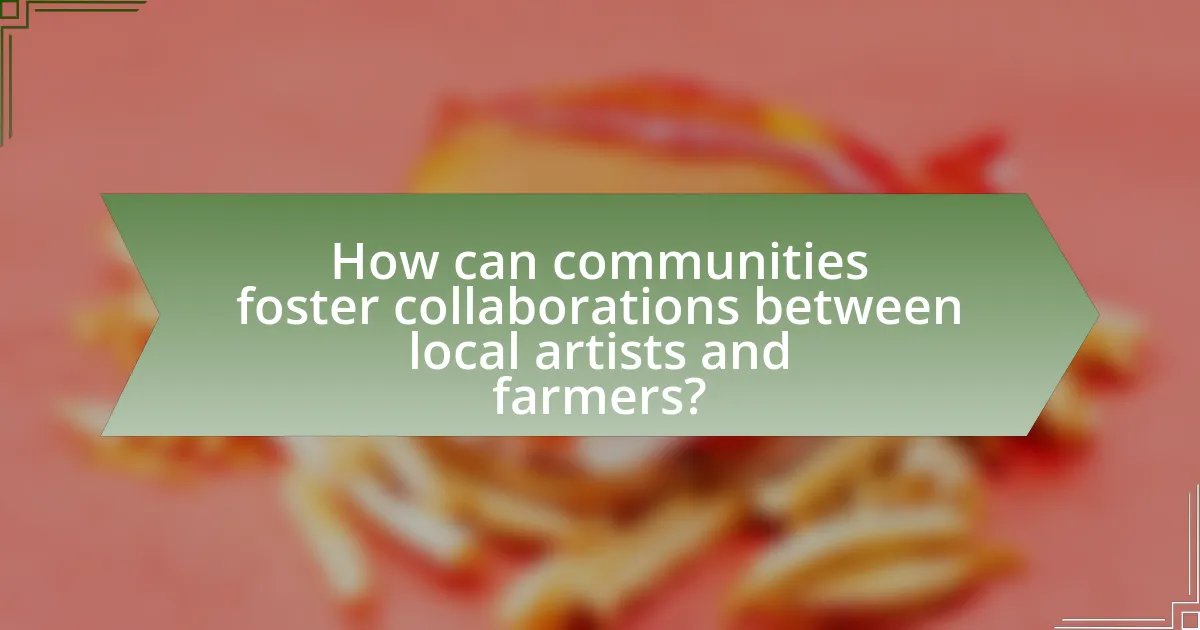
How can communities foster collaborations between local artists and farmers?
Communities can foster collaborations between local artists and farmers by organizing joint events such as farmers’ markets that feature art displays and performances. These events create a platform for artists to showcase their work while farmers sell their produce, encouraging interaction and mutual support. For instance, a study by the American Farm Bureau Federation highlights that integrating local art into agricultural settings can enhance community engagement and increase foot traffic, benefiting both artists and farmers economically. Additionally, establishing partnerships with local galleries to exhibit agricultural-themed art can further strengthen these collaborations, promoting a shared appreciation for local culture and sustainability.
What strategies can be implemented to encourage these partnerships?
To encourage partnerships between local artists and farmers, community engagement initiatives can be implemented. These initiatives may include organizing joint events such as farmers’ markets featuring local art displays, which can attract diverse audiences and foster collaboration. Research indicates that community events enhance social cohesion and promote local economies, as seen in studies by the American Planning Association, which highlight the positive impact of local collaborations on community development. Additionally, providing grants or funding opportunities specifically for projects that combine art and agriculture can incentivize partnerships, as evidenced by successful programs in various regions that have led to increased visibility and sales for both artists and farmers.
How can local governments support artist-farmer collaborations?
Local governments can support artist-farmer collaborations by providing grants and funding opportunities specifically designed for joint projects. These financial resources can incentivize partnerships that enhance community markets and promote local culture. For instance, the National Endowment for the Arts has documented that public funding for arts initiatives can lead to increased economic activity and community engagement. Additionally, local governments can facilitate networking events and workshops that connect artists and farmers, fostering collaboration and innovation. By creating policies that encourage the use of public spaces for art installations and farmer markets, local governments can further enhance visibility and accessibility for these collaborations, ultimately benefiting the community as a whole.
What role do community organizations play in facilitating these efforts?
Community organizations play a crucial role in facilitating collaborations between local artists and farmers by providing resources, networking opportunities, and support systems. These organizations often serve as intermediaries, connecting artists with farmers to create joint projects that enhance community markets. For instance, community organizations may organize events that showcase local art alongside agricultural products, fostering a vibrant marketplace that attracts more visitors. Additionally, they can offer grants or funding to support collaborative initiatives, ensuring that both artists and farmers benefit economically. This synergy not only promotes local culture but also strengthens community ties, as evidenced by successful programs in various regions that have increased market attendance and sales for both parties involved.
What are best practices for successful collaborations?
Best practices for successful collaborations include establishing clear communication, defining roles and responsibilities, and setting mutual goals. Clear communication ensures that all parties understand expectations and can address issues promptly. Defining roles and responsibilities helps prevent overlap and confusion, allowing each participant to contribute effectively. Setting mutual goals aligns the interests of local artists and farmers, fostering a shared vision that enhances collaboration. Research shows that collaborations with defined structures and open dialogue lead to higher satisfaction and better outcomes, as evidenced by successful community market initiatives that integrate diverse local talents and resources.
How can artists and farmers effectively communicate and plan together?
Artists and farmers can effectively communicate and plan together by establishing regular meetings and utilizing collaborative platforms for sharing ideas and resources. These interactions can be structured around specific projects, such as community events or market days, where both parties can discuss their needs and expectations. For instance, farmers can share their seasonal schedules and crop availability, while artists can present their creative concepts that align with agricultural themes. This mutual exchange fosters understanding and allows for the development of joint initiatives that benefit both groups, such as art installations that highlight farming practices or workshops that educate the community about local agriculture. Evidence of successful collaborations can be seen in community markets where local artists showcase their work alongside farmers, creating a vibrant atmosphere that attracts more visitors and enhances local economies.
What metrics can be used to measure the success of these collaborations?
Metrics that can be used to measure the success of collaborations between local artists and farmers include sales revenue, community engagement levels, and participant satisfaction. Sales revenue reflects the financial impact of the collaboration, indicating how well products are received in the market. Community engagement levels can be assessed through attendance at events, social media interactions, and feedback from local residents, demonstrating the collaboration’s reach and influence. Participant satisfaction can be measured through surveys and interviews with both artists and farmers, providing insights into their experiences and perceived benefits. These metrics collectively offer a comprehensive view of the collaboration’s effectiveness and impact on the community market.
What practical tips can local artists and farmers follow to collaborate effectively?
Local artists and farmers can collaborate effectively by establishing clear communication channels and shared goals. Regular meetings can help both parties align their visions, ensuring that artists understand the farmers’ needs and vice versa. Joint events, such as farmers’ markets featuring local art, can create a platform for visibility and sales, benefiting both groups. Additionally, artists can create promotional materials that highlight the farmers’ products, while farmers can provide artists with materials or inspiration for their work. This mutual support fosters a sense of community and encourages local patronage, which is crucial for sustaining both artists and farmers in the local economy.
